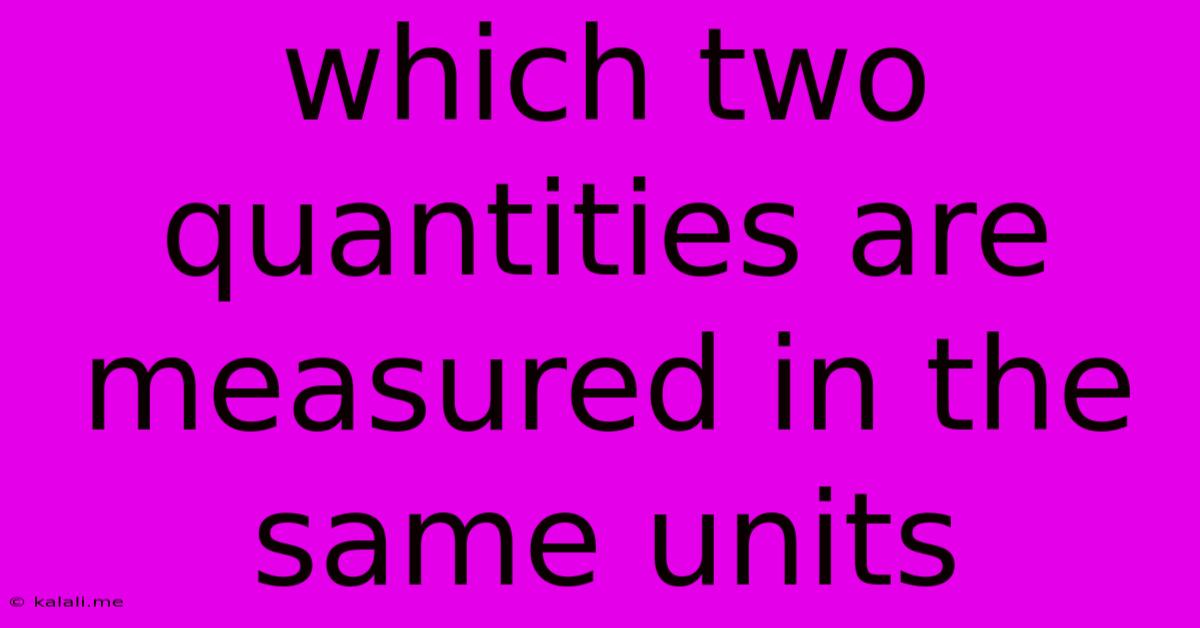Which Two Quantities Are Measured In The Same Units
Kalali
Jun 14, 2025 · 3 min read

Table of Contents
Which Two Quantities Are Measured in the Same Units? Understanding Work and Energy
This article explores the fascinating relationship between work and energy, two fundamental concepts in physics that share a crucial characteristic: they are measured in the same units. Understanding this connection provides a deeper insight into how these concepts interact and influence one another. This is a key concept for students of physics and engineering, and understanding the units involved is essential for problem-solving and analysis.
What is Work?
In physics, work is defined as the energy transferred to or from an object via the application of force along a displacement. It's a scalar quantity, meaning it only has magnitude, not direction. The formula for work is:
- Work (W) = Force (F) x Distance (d) x cos(θ)
where θ is the angle between the force vector and the displacement vector. This means that work is only done when the force causes a displacement in the direction of the force. Pushing against an immovable wall, for example, does no work, as there is no displacement.
What is Energy?
Energy, on the other hand, is the capacity to do work. It's a scalar quantity that comes in many forms, including kinetic energy (energy of motion), potential energy (stored energy), thermal energy (heat), chemical energy, and more. All forms of energy have the ability to perform work. For instance, a moving object (kinetic energy) can do work by colliding with another object. A stretched spring (potential energy) can do work by releasing its stored energy.
The Connection: Units of Work and Energy
The crucial point is that both work and energy are measured in the same units: Joules (J). One Joule is defined as the work done when a force of one Newton is applied over a distance of one meter. This fundamental connection highlights the intimate relationship between work and energy. The work done on an object results in a change in its energy. Conversely, the energy possessed by an object can be used to do work.
This shared unit underscores the principle of conservation of energy: energy cannot be created or destroyed, only transferred or transformed from one form to another. The work done on a system changes its energy content; the total energy remains constant unless external forces are involved.
Examples of Work and Energy in the Same Units
Several examples illustrate how work and energy are expressed using Joules:
- Lifting a weight: The work done in lifting a weight against gravity is equal to the increase in its potential energy.
- Accelerating an object: The work done in accelerating an object is equal to the increase in its kinetic energy.
- Compressing a spring: The work done in compressing a spring is equal to the increase in its potential energy.
In all these examples, the units of work done and the resulting change in energy are both measured in Joules.
Conclusion: A Unified Measurement
The fact that work and energy are measured in the same units—the Joule—is not a coincidence. It reflects the deep connection between these two fundamental concepts in physics. Understanding this relationship is essential to understanding how energy is transferred and transformed within systems. This fundamental concept provides a framework for understanding many physical phenomena, from simple mechanics to complex thermodynamic processes.
Latest Posts
Latest Posts
-
Cast Iron Has About How Much Carbon Content
Jun 15, 2025
-
Which Of The Following Are Financial Statements
Jun 15, 2025
-
Which Of The Following Is Not True About Vitamins
Jun 15, 2025
-
Distance Covered Per Unit Of Time
Jun 15, 2025
-
What Is The Gpa Requirement For Lsu
Jun 15, 2025
Related Post
Thank you for visiting our website which covers about Which Two Quantities Are Measured In The Same Units . We hope the information provided has been useful to you. Feel free to contact us if you have any questions or need further assistance. See you next time and don't miss to bookmark.